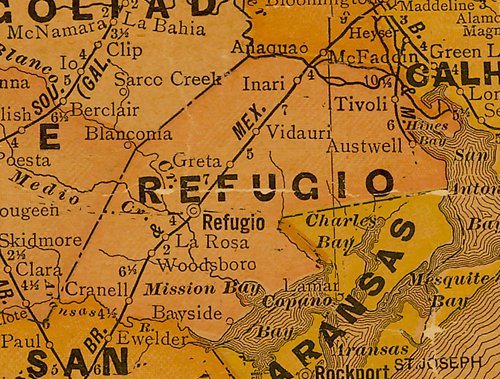Bayside, Texas, Refugio County. (original) (raw)
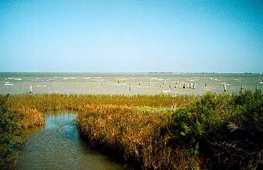
Bay side at Bayside
TE photo, 2001
History in a Pecan Shell
In 1908 two experienced developers - E.O. Burton and A.H. Danforth acquired the land of what had been a community called Black Point. The land was promoted as being ideal for truck farming. With St. Joseph's Island and the Rockport/ Fulton peninsula, Bayside seemed well protected against storms.
The town was platted and beachfront was reserved for public use. In addition, a public well was drilled and buyers were encouraged by the incentive of a town lot for every five-acre plot that was sold.
In 1909 and 1910, the developers acquired adjoining land that was the former town of St. Mary's of Aransas. The cemetery of St. Mary's is still in use for Bayside residents.
Bayside was successful - perhaps a bit too successful.
Although the property was bought immediately, most of the buyers were speculators and few people actually moved onto the property. A lack of people usually equals a poor economy.
Bayside got a post office in 1909, but most trade was inconveniently across Copano Bay at Rockport.
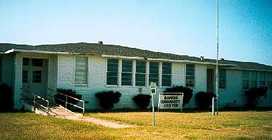
The Bayside School, now Community Center
TE photo, 2001
They built a school in 1912 and a church in 1913. Five different denominations shared the building. The 1919 hurricane that dashed dreams all along the Texas coast wiped the Bayside beach clean of improvements.During the Great Depression delinquent property was sold at public auction.
The town incorporated in 1977 and the current population is now at the highest point in the town's history.

A welded tombstone in Old St. Mary's Cemetery
TE photo, 2001
Historical Marker: From Bayside, FM 136 N 1 mile, then Cemetery Drive Eat about 0.5 mile.
Old St. Mary's Cemetery
Joseph F. Smith, Nephew of Texas' provisional governor Henry Smith, founded the town of St. Mary's in 1857. Ten acres were set aside for this burial ground, in which the earliest marked grave is dated 1860. The cemetery served the thriving community until an 1886 storm destroyed business and homes, causing residents to move away. In 1909, with the return of land development to the area, the cemetery was again used. The burial site of war veterans and pioneer area settlers, the cemetery serves as a reminder of the important early coastal town of St. Mary's.
(1983)
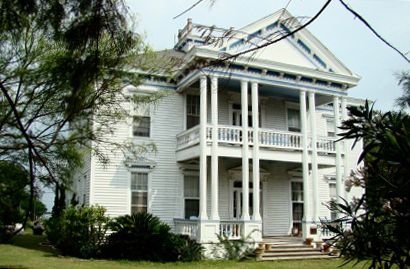
John H. Wood House c. 1875 weathered both the 1919 hurricane and another more destructive one in 1942.
National Register of Historic Places
Recorded Texas Historic Landmark
Photo courtesy Ken Rudine, May 2007
Historical Marker: Copano Bay Blvd. at Wood Ave., Bayside
John Howland Wood and Nancy Clark Wood House
John Howland Wood (1816-1904) was born in Dutchess County, New York. Trained in the mercantile trade and apprenticed to a painter, Wood enlisted in the New York Battalion to aid the Texas revolution. He arrived in Texas in 1836 in time to participate in the Battle of San Jacinto and several other major events at the close of the war. Wood settled at Victoria as quartermaster of the Texas Army, marrying Nancy Anna Clark in 1842. They became civic and political leaders and the parents of twelve children.
The Woods moved to St. Mary's, later called Bayside, where they opened a mercantile business and began to acquire vast land holdings throughout the state while John established himself as a cattleman. In 1849 they purchased this property, establishing a ranch which Nancy Wood dubbed "Bonnie View." Lightning damage to the original house led to the construction of this magnificent edifice on its foundations in 1875.
Erected by contractors Viggo Kohler and Hugo Heldenfels, the structure combines a typical Greek revival plan with exuberant high Victorian Italianate detailing. The two-tiered, full-height projecting portico supported by Italianate columns establishes the house's imposing character. The house also features pedimented window surrounds, bracketed eaves and a "widow's walk" or "captain's walk," reflecting the architecture of John Wood's native New York.
The house's presence on the rural Texas Coast, where few mansions were built, surely impressed visitors and area residents alike during the post-Civil War era. An outstanding example of the Italianate style, it remains one of the area's most substantial and least-altered country mansions of the period. It was listed on the National Register of Historic Places in 1983.
Recorded Texas Historic Landmark - 1998
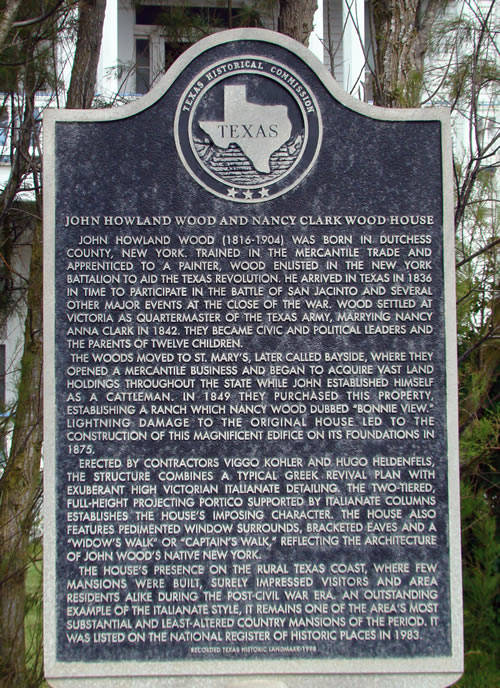
John Howland Wood House Historical Marker
Photo courtesy Ken Rudine, May 2007
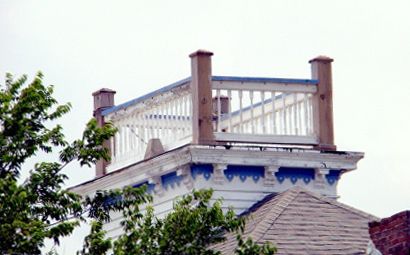

Driscoll Rooke Covenant Park
Photo courtesy Ken Rudine, May 2007
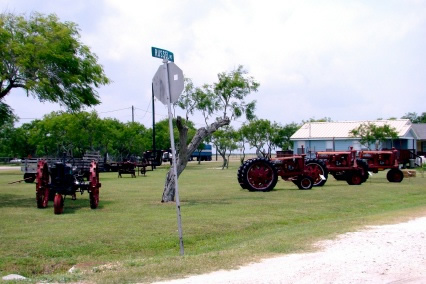
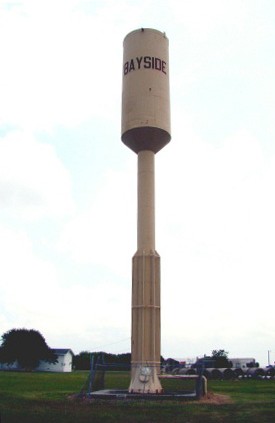
The Bayside water tower
Photo courtesy Ken Rudine, May 2007
Refugio County 1920s map showing Bayside and Copano Bay
From Texas state map #10749
Courtesy Texas General Land Office
Texas Escapes, in its purpose to preserve historic, endangered and vanishing Texas, asks that anyone wishing to share their local history, stories, landmarks and recent or vintage photos, please contact us.
